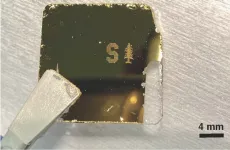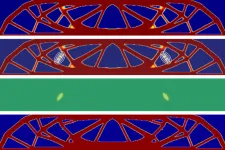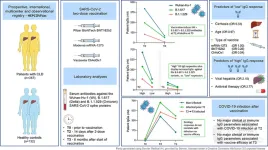(Press-News.org) Within minutes, a statistical model based on a global database of public reports of ground shaking can be used to identify an earthquake as a high- or low-impact event, according to a new study published in The Seismic Record.
High-impact earthquakes, as defined by the study, are those associated with at least one destroyed building, at least 50 damaged buildings, at least two deaths, or any documented financial losses.
The researchers were able to provide impact results for 393 global earthquake events from 2021 within 10 minutes. Their model was developed using more than 1.5 million globally collected felt reports from more than 10,000 earthquakes of any magnitude between 2014 and 2021. The reports come from the Euro-Mediterranean Seismological Center (EMSC)’s LastQuake app, which alerts populations and collects user reports of earthquake shaking in real time.
While their model still has some challenges separating some high versus low-impact events, the model was able to definitively label a large number of events as low-impact, according to University of Potsdam researcher Henning Lilienkamp and colleagues.
Quickly determining the impact of an earthquake is essential for decision-makers and emergency response operators, as they guide the immediate direction of the actions that can protect lives and mitigate further damage.
Of course, in some cases such as the February 2023 catastrophic sequence of earthquakes affecting parts of Turkey and Syria, “it is immediately clear that emergency measures are urgent,” Lilienkamp said.
Events like the magnitude 5.9 earthquake that hit remote areas of Afghanistan and Iran on 12 June 2022, causing over 1000 fatalities, “are where our model could be of interest, because, according to the EMSC, it was not clear for hours whether considerable impact was to be expected or not,” he added.
Rapid assessment impact systems such as the U.S. Geological Survey PAGER provide impact estimates within 30 minutes—although they can return results in as little as five minutes in heavily instrumented areas—using ground acceleration data and other seismic observations, along with crowdsourced reports.
While many kinds of data can go into assessing an earthquake in its immediate aftermath, EMSC “has built up a huge source of information that has barely been utilized in a quantitative way in seismic hazard and risk-related studies so far,” Lilienkamp explained. “We were convinced that this database is too valuable to be disregarded in the long run, because it is collected efficiently and on a global scale, including in regions that lack expensive seismic instrumentation.”
The goal of Lilienkamp and colleagues was to see whether a useful assessment could be developed quickly using only crowdsourced data. The basis of their method converts a felt report into a “pseudo-intensity” value that quantifies the level of shaking.
Being able to identify an earthquake as low impact could provide some comfort to the public, as these kinds of earthquakes can still be felt and may cause anxiety as a result, the researchers note in their paper.
Lilienkamp and colleagues suggest that their method could be used to develop a “traffic light” system based on impact scores, where green-level scores would require no further action by decision-makers, yellow would prompt further investigation, and red could raise an alert.
“As seismologists, we need to get a better understanding of how exactly decision-makers and emergency services like fire departments actually act in case of an emergency, which kind of information is useful, and at which probabilities of high impact they would prefer to raise an alarm,” said Lilienkamp. “Careful communication of our model’s abilities and the individual needs of potential end-users will be key for a practical implementation of traffic-light systems.”
For the 6 February sequence in Turkey, Lilienkamp said the LastQuake service collected about 6500 reports from the first magnitude 7.8 shock and about 4800 reports from the second magnitude 7.5 shock. “For the first shock it took about four and a half minutes to collect 50 reports—the number required to run our model—and after 10 minutes 1232 reports were available.”
As is usual, there was an initial lack of reports from the area where shaking was most intense. “This effect is well known and represents the fact that people under such extreme circumstances of course prioritize finding shelter and rescuing people in danger, over submitting felt reports on their smartphones,” Lilienkamp said.
END
Crowdsourced reports can quickly identify an earthquake’s impact
2023-03-02
ELSE PRESS RELEASES FROM THIS DATE:
Ocean surface tipping point could accelerate climate change
2023-03-02
The oceans help to limit global warming by soaking up carbon dioxide emissions. But scientists have discovered that intense warming in the future could lessen that ability, leading to even more severe warming.
The discovery comes from a study led by The University of Texas at Austin in which researchers analyzed a climate simulation configured to a worst-case emissions scenario and found that the oceans’ ability to soak up carbon dioxide (CO2) would peak by 2100, becoming only half as efficient at absorbing the greenhouse gas by 2300.
The decline happens because of the emergence of a surface layer of low-alkalinity water ...
DRI announces space education trainings for Nevada teachers
2023-03-02
DRI is pleased to announce “Space Education Educator Professional Development Training,” available for 80 educators. The training will be conducted in Las Vegas and Reno by four Nevada educators who were selected to attend the NASA Space Exploration Educators Conference in Houston in February. In addition to touring NASA facilities, the conference provided hands-on training in lesson plans and activities, and these educators will use the knowledge they gained to teach Nevada teachers.
“DRI is pleased to offer NASA-approved space education training to ...
Stanford researchers develop a new way to identify bacteria in fluids
2023-03-02
Shine a laser on a drop of blood, mucus, or wastewater, and the light reflecting back can be used to positively identify bacteria in the sample.
“We can find out not just that bacteria are present, but specifically which bacteria are in the sample – E. coli, Staphylococcus, Streptococcus, Salmonella, anthrax, and more,” said Jennifer Dionne, an associate professor of materials science and engineering and, by courtesy, of radiology at Stanford University. “Every microbe has its own unique optical fingerprint. It’s like the genetic and proteomic code scribbled ...
Integrating humans with AI in structural design
2023-03-02
Modern fabrication tools such as 3D printers can make structural materials in shapes that would have been difficult or impossible using conventional tools. Meanwhile, new generative design systems can take great advantage of this flexibility to create innovative designs for parts of a new building, car, or virtually any other device.
But such “black box” automated systems often fall short of producing designs that are fully optimized for their purpose, such as providing the greatest strength in proportion to weight or minimizing the amount of ...
Foundation for anesthesia education and research establishes endowed NAM fellowship
2023-03-02
CHICAGO – The Foundation for Anesthesia Education and Research (FAER) announced it has established an endowed National Academy of Medicine (NAM) fellowship to provide early-career anesthesiology scholars with the opportunity to experience and participate in committee, workshop, and roundtable activities of NAM and the National Academy of Sciences (NAS).
Offering a robust catalogue of research grants and programs for early-career anesthesiology investigators, FAER – an American Society of Anesthesiologists’ foundation – is always exploring new avenues of support for up-and-coming researchers. The NAM Fellowship Program was recognized as one such ...
Liver cirrhosis is associated with a lower immune response to COVID-19 vaccines but not with reduced vaccine efficacy
2023-03-02
Amsterdam, March 2, 2023 – The overall responsiveness of patients with chronic liver disease (CLD) to COVID-19 vaccines has been shown to be decreased in patients with cirrhosis. A new prospective study in JHEP Reports, published by Elsevier, now shows that this lower response is observed up to six months following two-dose COVID-19 mRNA vaccination, but it does not reduce vaccine efficacy.
In this prospective study, more than 350 patients with CLD were recruited in clinical centers from Austria, Belgium, Italy, Portugal, Romania, and Spain. Cirrhosis, alongside age and vaccine ...
Human norovirus GII.4 exploits unexpected entry mechanism to cause gastroenteritis
2023-03-02
Human noroviruses are the leading cause of acute gastroenteritis worldwide, a major global health problem for which there are no specific treatments or vaccines. Understanding the first phase of infection – the process the virus follows to invade cells – is a decisive step in the development of effective preventive and therapeutic strategies. A team led by researchers at Baylor College of Medicine is making strides in that direction.
The researchers report in the journal Nature Communications that the globally dominant human norovirus GII.4 strain invades gastrointestinal cells via an unexpected mechanism. The viral strategy involves interactions ...
AI predicts cancer patient survival by reading doctor's notes
2023-03-02
A team of researchers from the University of British Columbia and BC Cancer have developed an artificial intelligence (AI) model that predicts cancer patient survival more accurately and with more readily available data than previous tools.
The model uses natural language processing (NLP) – a branch of AI that understands complex human language – to analyze oncologist notes following a patient’s initial consultation visit—the first step in the cancer journey after diagnosis. By identifying characteristics unique to each ...
For older adults, every 500 additional steps taken daily associated with lower heart risk
2023-03-02
Research Highlights:
A study of people ages 70 and older found walking an additional 500 steps per day, or an additional quarter mile of walking, was associated with a 14% lower risk of heart disease, stroke or heart failure.
Compared to adults who took less than 2,000 steps per day, adults who took about 4,500 steps per day had a 77% lower observed risk of experiencing a cardiovascular event.
Only about 3.5% of participants who took around 4,500 steps per day had a cardiovascular event, compared to 11.5% of those who took less than 2,000 steps per day, over the 3.5-year follow-up period.
Embargoed until 10:45 a.m. CT/11:45 a.m. ET, ...
American Society for Metabolic and Bariatric Surgery supports new clinical guidance on treatment of obesity in children and teens
2023-03-02
The American Society for Metabolic and Bariatric Surgery (ASMBS) fully supports the new “Clinical Practice Guideline for the Evaluation and Treatment of Children and Adolescents With Obesity” issued from the American Academy of Pediatrics (AAP) calling for earlier and more intensive treatment of obesity in children and teens. Published in the journal Pediatrics in February, this is the first comprehensive guideline on obesity in 15 years from the AAP, the largest professional association of pediatricians in the U.S.
According to AAP, more evidence ...



